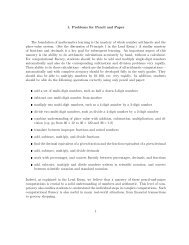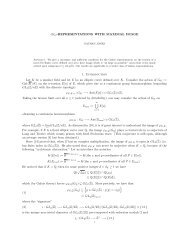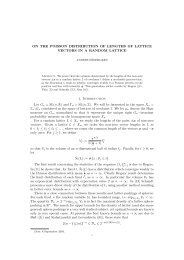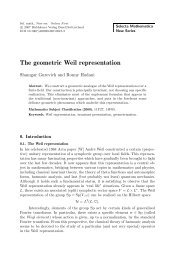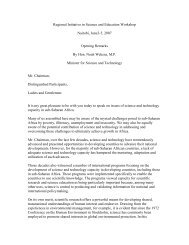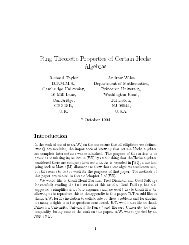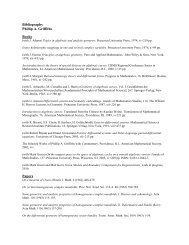Comparing 2D and 3D Systems - IAS
Comparing 2D and 3D Systems - IAS
Comparing 2D and 3D Systems - IAS
You also want an ePaper? Increase the reach of your titles
YUMPU automatically turns print PDFs into web optimized ePapers that Google loves.
possible that the Voronoi construction is more “similar” to the steady state in higher dimensions.Alternatively, it is possible that someoneFor two-dimensional simulation data, we begin with one system containing 10,000,000 grains, <strong>and</strong>allow it to evolve until it has reached a steady state when roughly 400,000 grains remain. Statisticsfrom a total of 1,000,000 cells were collected from four different points in time after the system hadreached that point.For three-dimensional systems, we collected data from thirteen trials, each of which began with100,000 grains <strong>and</strong> each of which had reached a steady state when roughly 10,700 grains remained.We also collected data from two larger systems, one which began with 250,000 grains <strong>and</strong> whichreached a steady state when roughly 17,000 grains remained, <strong>and</strong> one which began with 500,000grains <strong>and</strong> which reached a steady state when roughly 42,000 grains remained. We report statisticsfrom roughly 200,000 grains in the steady state. These large sample sets are necessary for producingaccurate statistics of the steady state structure.For the cross-sectional data, we used cross-sections of all three-dimensional samples. In eachsystem we took a series of cross-sections parallel to the xy−, yz−, <strong>and</strong> zx− planes. We spacedthe cross-sections roughly five grain diameters apart, to decrease any correlation between nearbycross-sections. In total we sampled roughly 100,000 grains for this data. We use the term <strong>3D</strong>X asshorth<strong>and</strong> to refer to data from these cross-sections.We divide data for the three systems into three groups. First we report statistics that describethe distributions of individual grains in the system as classified by various single-grain quantitiessuch as their their areas or volumes. We call these measurements point quantities. Next we reportcorrelations between neighboring grains that are a certain metric distance apart.For example,we consider how the size of a grain is correlated with grains that are three grain diameters away.Last, we consider relationships between a grain <strong>and</strong> its topological neighbors. That is, we considerthe correlation between nearest neighbors, second nearest neighbors, <strong>and</strong> so forth. We introduce amethod of describing second <strong>and</strong> third nearest neighbors which is different from the st<strong>and</strong>ard methodused in the literature, <strong>and</strong> show that this definition should be used in reporting data of this kind.These correlations between a grain <strong>and</strong> its neighbors can help us measure the local order inherentin grain-growth structures.Where possible, we compare analogous results for two-dimensional simulations, three-dimensionalsimulations <strong>and</strong> cross-sections of three-dimensional simulations, referred to as <strong>2D</strong>, <strong>3D</strong>, <strong>and</strong> <strong>3D</strong>X,respectively. Error bars in all plots indicate the st<strong>and</strong>ard error from the mean of these samples.135



